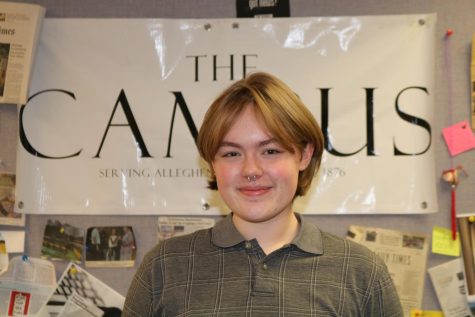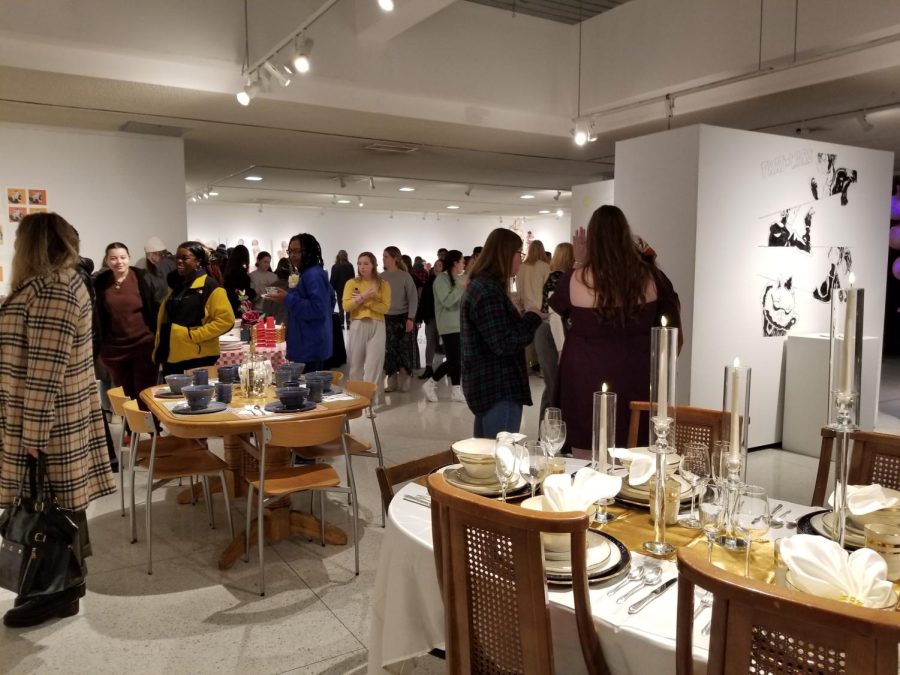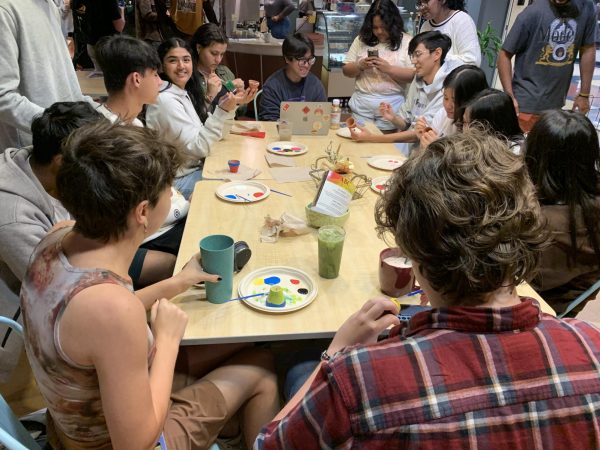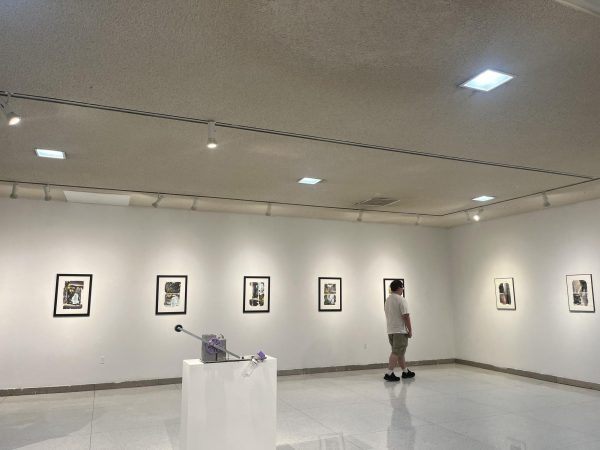“Mandatory” art exhibit showcases variety of artistic mediums
A collection of posters scattered around the Allegheny campus this past week had one message to get across: supporting the arts is a campus-wide necessity. As students and faculty members filled the Allegheny Art Gallery, it was clear that, although the “Attendance Mandatory All-Campus Event,” was not actually mandatory and rather a title to garner an audience, Allegheny campus is alive with a love for the arts. The event took place on Tuesday Dec. 6 at 5:30 p.m. in Doane Hall of Art and featured a dozen junior seminar and senior comprehensive projects.
Attendees were offered hors d’oeuvres — and wine for those of-age — and were encouraged to mingle with the artists of the event, who donned red and white roses as indicators that they had created a piece in the gallery.
The projects took a variety of mediums — photography, paintings, ceramics, prints, sculpture and digital projection were all present in the gallery, and each told a story. The variety is something that Assistant Professor of Art Ian Thomas, who helped coordinate the event and student projects, says was intentional in the gallery. He said that students could pull from personal experience, rather expect a set of guidelines from him.
“The idea is coming from the student, not from me,” Thomas said.
He said that students in his class were allowed to take any concept that was relevant to them and make a work out of it.
“Whether it’s about identity or roles of masculinity or class, I think that these are things that (…) are made for them, or their generation,” Thomas elaborated.
For Dawson Thomas, ’23, inspiration came from the intersection between masculinity, vulnerability and capitalism. Art, they explained, is important for several reasons. The cross-section of their work responded to a larger cultural theme, in an attempt to make those themes explicit to viewers through a visual medium.
“The arts are really important because they are responsive to our culture. They create culture, respond to culture and therefore create new culture,” Dawson Thomas said.
Not only was Dawson Thomas’s project a cultural overlap, but it was also an overlap between the arts and sciences. The overlap between computer science and traditional art are something they hope becomes better understood; technology and art are not mutually exclusive.
“The arts are really expansive,” they said, in explaining the context of their project. “The applicability of doing something that’s both creative and STEM-related is so much more valuable than just looking at it from one side or the other. So really, we should try to approach STEM from an artistic point of view and maybe approach the arts sometimes from a scientific point of view, and merge the two together.” Dawson Thomas’s work included a projection system, as well as a motion-sensored element, which they saw as a way to push the boundaries of art, science and utility.
“I’m not a computer science major, I barely know computer science, but I wanted to make something that responded to your movement,” Dawson Thomas explained. The gap between what is and is not considered art is something that other artists at the exhibition explored in various mediums.
Another artist, Savannah Willis, ’23, bridged a similar gap through her work. Her piece incorporated ceramics on three separate dining room tables to showcase how class is not synonymous with love, and that material things are not the factor that makes time together enjoyable. The place settings took different forms to showcase differences in class, but the core message was one that highlighted the similarities, rather than the differences, between the tables.
“It has evolved into me thinking about: is it the things that we surround ourselves with, or is it the people we surround ourselves with to show love?” she said.
Willis, similar to Dawson Thomas, wanted to highlight that art is not limited to one intention. Similar to how art can intertwine with STEM, art can also intertwine with everyday function. Technology does not have to exclude art, just as a functional piece — like a table setting — does not have to exclude artistic elements.
“I’m a ceramic artist, and I think that ceramic gets funneled in with utility, and I think it can be both,” Willis explained. “Art is utility and utility is art.”
Thomas’ and Willis’ pieces were placed at the front of the gallery space. From there on, though, attendees were met with a variety of pieces in any and all mediums. And in a room packed with people, there was a commotion and movement that led attendees from one artwork to another with flow.
The consensus was an admiration for the arts and the time and care that students put into their works. For many students, it was a look into a side of campus that they otherwise would not get to see first-hand. The gallery was a collective look into the visual arts department, serving the same function as a dance recital, play or concert.
“It’s cool to get a window into that side of things on campus, and it’s exciting to see a lot of people here,” said Elsa Waidelich, ’25. Elsa, like many students in attendance, was there to support a friend who had created a piece but took in the rest of the artworks nonetheless.
The high attendance was something Ian Thomas highlighted in his brief message to the attendees. He thanked everyone for coming out to support the arts, and told attendees to mingle with the artists by asking questions about their work. “We’re a small community. I think one of the most important things is supporting each other, no matter what the event is,” Ian Thomas said.
The pieces will remain up throughout the next week, perhaps beyond, during the usual gallery hours. And while the gallery is an annual, capstone event for juniors and seniors in the art program, Ian Thomas summarized his thoughts prior to the event by highlighting how supportive not only the Allegheny community has been toward the art program, but how supportive the artists have been towards each other this year. The attendance of friends and peers alike emphasized his point.
“I think that this particular group was extremely supportive of one another and I’m really proud of what they did,” Ian Thomas said.

Sam Heilmann is a sophomore from Johnstown, PA. She is majoring in Communications. This is her second year on the Campus staff, and her first as Opinion...






